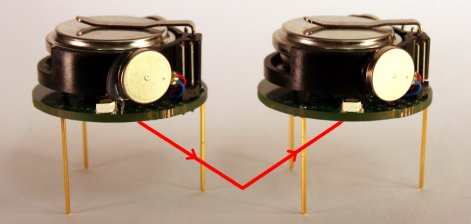Reader, [Michael Rubenstein], sent in a project he’s been working on. Kilobot, as stated in the paper(pdf), overcomes the big problems with real world swarm robotics simulations; cost, experiment setup time, and maintenance. The robot can be communicated with wirelessly, charged in bulk, and mass programmed in under a minute. Typically, robots used for swarm research cost over a $100, so large scale experiments are left to software simulation. These, however, rarely include the real world physics, sensor error, and other modifying factors that only arise in a physical robot. Impressively enough, the kilobot comes in far under a hundred and still has many of the features of its costlier brothers. It can sense other robots, report its status, and has full differential steer (achieved, surprisingly, through bristle locomotion). There are a few cool videos of the robot in operation on the project site that are definitely worth a look.
13 thoughts on “$14 Swarm Robot, Kilobot, Is Extremely Cool”
Leave a Reply
Please be kind and respectful to help make the comments section excellent. (Comment Policy)
















That is rather good. I like the way they measure proximity and communicate via a single infra red transceiver. Very neat.
Only suggestion I have is that they could potentially “feed” (charge) autonomously if the three legs were connected to the existing charging circuit via a three pole bridge rectifier and the table were make into a grid of conductive squares with alternating connections to GND and 6V. That way, so long as one leg is straddling a break, the charger sees a voltage.
I first read killbot, and got super excited! but these things are freaking awesome. Just need to add some lasers or saw blades onto them!
I saw these at the Boston Science Museum! their darn great! how can i get em? hihihi
@CodeWhite
Why attach things which require a constant source of power? Simply pack small C4/RDX charges on the little things and have at ’em!
Seriously though. KILLbot is what i read as well..
-_-
imo not being able to recharge on their own is a serious flaw in a design “hundreds or even thousands of robots”. That’s a fair few batteries to be changing by hand.
somewhat similar robot swarm: http://warrantyvoidifremoved.com/taxonomy_menu/18/17/12
@nave.notnilc They have thought about the charging problem; to charge these bots, you place them on a conductive surface with their feet, and press a conductive surface on top of them.
Put 6VDC between the two conductive surfaces, and the bots will begin charging.
I can see a system like that working for charging thousands of bots at once, no problem.
@Wirf,
do you remember what happened when the spaniel got into your bot-charging-clamp-table?
DO YOU?
DO YOU!!!?
think of the spaniels, man!
It would be interesting to use rechargeable AAA’s and some unsuspecting grad assistants.
These would be very cool educational bots.
Are wireless electricity receptors small enough yet to make that a practical charging alternative?
i want some it would be cool to have some to show to one of my teched teachers
Is HaD not including videos in posts anymore? This is the second post I’ve checked today where I’ve had to click away to find the video :/
how is differential/directional motion achieved with vibration motors?
It’s pretty common for something to suck and for someone to say, “but if i had 1,000 of them it would be awesome.” That only makes it seem awesome because it makes it seem as if someone else liked the idea enough to invest the resources/$ to make 1,000 of them.
Swarm robots? eh. A lot of people seem to abuse the “lego metaphor.” They think that if you have enough of something you only need one type of thing and you can do anything. But think about a simple material like wood— there are hundreds of different machines for working wood. It’s not the material/wood/robot itself that is exciting. It’s a nicely made banister, or cabinet, etc.